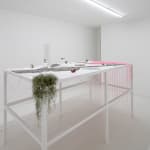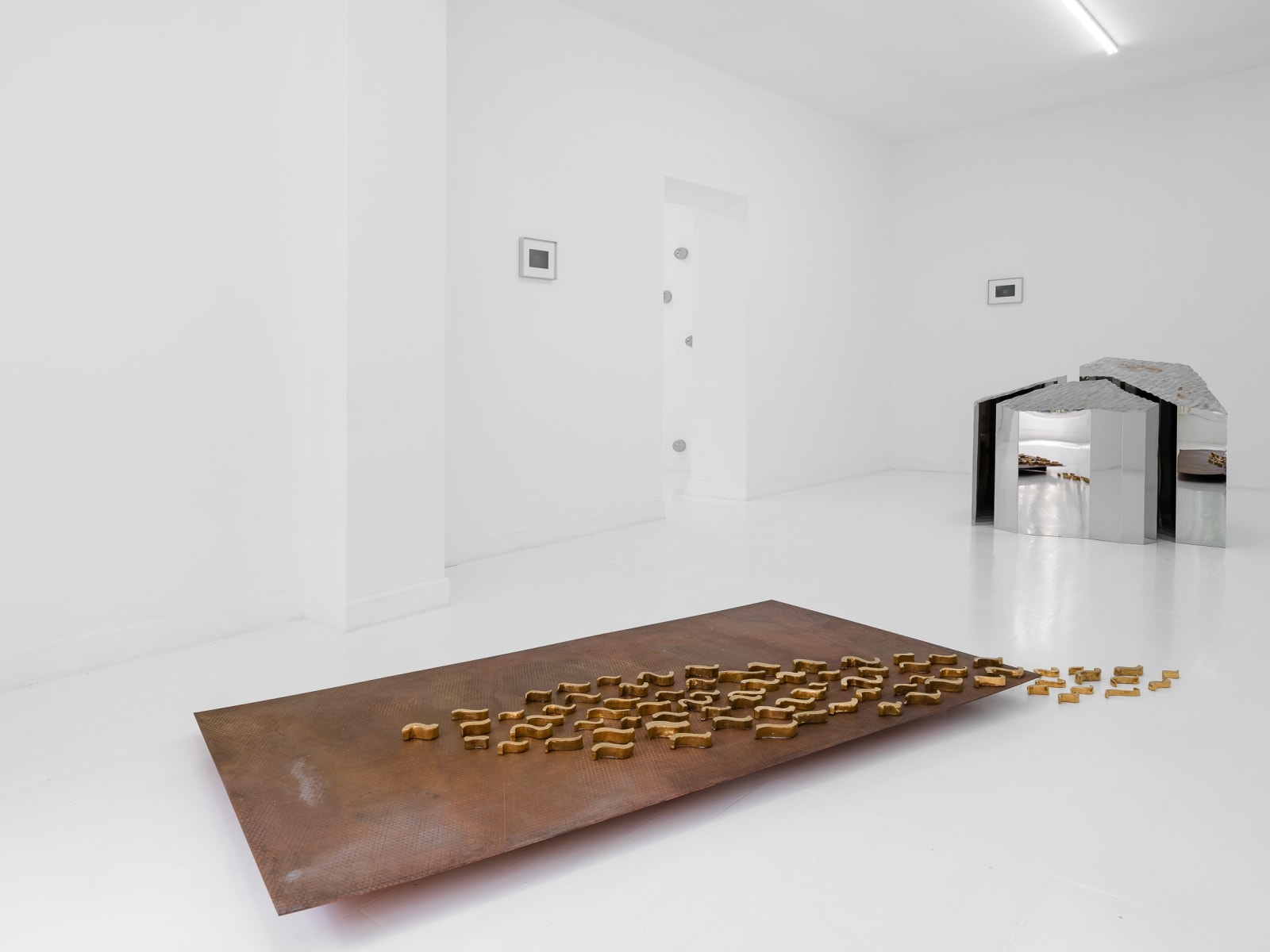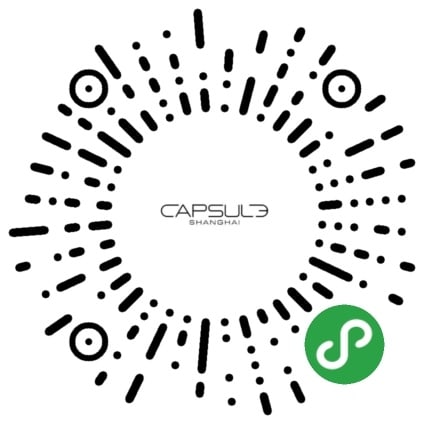-
Alice Wang 王凝慧
Untitled 无题, 2021prism, Crookes radiometer, hand-made white gold tiles, air plants, fluorescent pink isometric grid, wet plate collodion photographs on mirror, glass microspheres 棱镜,克鲁克斯辐射计,手工白金瓷砖,气生植物,粉色织网,湿版火棉胶摄影印于镜子上,玻璃珠121.92 x 243.84 x 121.92 cm
48 x 96 x 48 inFurther images
-
(View a larger image of thumbnail 1
)

-
(View a larger image of thumbnail 2
)

-
(View a larger image of thumbnail 3
)

-
(View a larger image of thumbnail 4
)

-
(View a larger image of thumbnail 5
)

-
(View a larger image of thumbnail 6
)

-
(View a larger image of thumbnail 7
)

-
(View a larger image of thumbnail 8
)

-
(View a larger image of thumbnail 9
)

A single untitled sculpture dominates the space: a large, chest-height table. On this table, the viewer is confronted by a landscape of curiosities at eye-level that manifest the ethereal, dynamic,...A single untitled sculpture dominates the space: a large, chest-height table. On this table, the viewer is confronted by a landscape of curiosities at eye-level that manifest the ethereal, dynamic, and nutritive faculties of light and air. Wang constructs a laboratory that toys with the materials and concepts of electromagnetism, thermodynamics, quantum mechanics, and multidimensionality.
Light, which typically illuminates the art object, is here experimented with and materially constitutes the work itself. A monolithic triangular glass prism distorts and diffracts, highlighting the physical reality of light as electromagnetic waves radiating through space. The prism disperses light into its spectral components which we experience as the colors of the rainbow. A Crookes radiometer perpetually spins, converting electromagnetic radiation into rotational energy. Mysterious wet-plate collodion on mirror photographs of the surfaces of Mercury and Iapetus confound, indices of light reflected off of celestial bodies. Air plants grow without substrate, deriving moisture and nutrients from the atmosphere alone while photosynthesizing in the sun, becoming physical manifestations of air. Circumnavigating the scene reveals the items' meticulously casual arrangement; the abandoned workshop of a bygone-or future-scientist re-staged for our perusal.
These objects are arranged within a constructed environment tessellated by hand-made white gold tiles, draped with fluorescent netting, and mulched with glass microspheres. The translucent glass beads swirl and accumulate, forming dunes and lakes. They are at once particle and wave, coming together fluidly before scattering apart into discrete alterities. The net and tiles both employ the same logic of a grid of equilateral triangles, commonly used by engineers and architects for isometric projection, the encoding of three-dimensional space in two dimensions. These spatial representations, called dengjiao toushi, were utilized in classical Chinese scroll painting, predating linear perspective in the West. In a hand scroll all scenes exist concurrently at the same scale, available for the viewer to explore in non-distorted space and navigate through time.
Here, Wang makes perception itself both her subject and matter, materializing light and the air through which it transmits into sculpture. The projection from a two dimensional picture plane into three generates a consideration of higher dimensions: Einstein's four-dimensional spacetime, string theory's ten dimensions, and M-theory's eleven. Wang prompts the understanding of the self and environs as quantum. We are both material and immaterial, subject and stranger, individual and multitude, dispersed and diffracted through space and time.
一个无题的雕塑主宰了空间:一张大型的高度齐胸的桌子。呈现在观者眼前的是桌面上各种物件所形成的地景,这些物件皆是光和空气的轻盈、动态和所含养分的体现。艺术家在这个她所构筑的实验台上玩味电磁学、热力学、量子力学和多维性的材料和概念。
通常光线仅仅被用于照亮艺术品,而在此光本身即是实验的对象,也是构成作品的物质。桌面上一块三棱镜将光线扭曲和衍射,凸显光作为电磁波在空气中传播的事实。三棱镜把穿过其中的光分离成光谱的组成部分,形成肉眼可见的彩虹般的色彩。克鲁克斯辐射计不停地转动着,将电磁辐射转化为叶片旋转的动能。镜面上的湿版火棉胶摄影描绘了水星和土卫八的神秘景象,鉴证着光在天体表面的折射。气生植物从空气中获取水和养分,依赖阳光进行光合作用,无需土壤即可生长,成为了空气的具象表现。环绕桌子观看即可发现这些物件看似随意的排布实则经过精心设计。一位过去—或未来--的科学家遗留下来的工作台在此重现,供我们赏读。
这些物件之间穿插着手工白金釉面的砖片,覆盖着微型玻璃珠,荧光色的织网垂落桌边。半透明的玻璃珠盘旋堆积,形成沙丘和湖泊,它们同时兼具粒子和波的形态,流动聚集,而后散落为离散的个体。织网和砖片都采用了等边三角形的结构,这种几何图形常用于工程师和建筑师图纸的等角透视法,将三维空间转化为二维平面。等角透视早在古代中国就被用于卷轴画中,先于西方的直线透视。在长卷画中所有的图景以相同的比例同时存在于画面中,观者可在一张画中看到不同时空发生的场景,所见的空间亦未经扭曲。
在这件作品中,感知既是主题也是材料,艺术家为光和空气赋予了实体,将它们塑造成雕塑。从二维画面到三维空间的转换引起对更高维度的注意--爱因斯坦提出的四维时空,弦理论中的十个维度,M理论的十一维时空。王凝慧引导观者从量子的角度理解自身和环境。我们既是物质的亦是非物质的,既是主体也是客体,既是独立个体也是群体,散落在时空中。 -
(View a larger image of thumbnail 1
)
Alice Wang - Virtual Tour of the Exhibition
Checking your information
Please check your email
We have sent you an email with a link to access this page.










